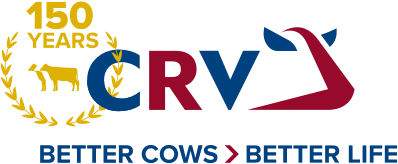Over the last 13 years, Southland dairy farmers Caleb and Paula Hamill have worked hard to realise their dream of farm ownership. Setting firm goals to help fast track the genetic gain of their herd has been one of the keys to their success.
The Hamill’s own Hamkee Dairies Limited near Winton milking 465 Friesian crossbred cows at peak through a 50-bale rotary on 162 effective hectares.
For the last three years they have leased a 75-hectare runoff, six kilometres from the home farm where they rear 260 replacements R1s and R2s each year and winter around 120 mixed age cows.
The Hamill’s started their journey with CRV in 2018 as a Progeny Test farm. They then went on to use a nominated bull team and in recent years have explored the benefits of sexed semen.
Their farm boasts impressive production figures with cows yielding over 2.5 milk solids per cow at peak and holding well through the season. Last season, Caleb and Paula achieved production of 545 kgMS per cow, despite a drop in reproductive performance.
“Historically we've had an 81% 6-week in calf rate with 5-7% empty. And then, last year our 6-week in calf rate dropped to 71% and 17% of the herd was empty,” says Caleb.
“We grew a lot of feed down here last season, but I expect there wasn’t enough guts in it, and we just did too much milk. The cows might have been full but potentially they couldn’t eat enough to get the nutrition they needed.”
This setback prompted Caleb and Paula to sit down with their CRV sales consultant Tony Watt as part of a broader review of their farm operation. They worked together to look at the farm’s goals and discuss how they could fine tune their breeding strategy to achieve them.
“Tony used to be our AI technician, so we know him well and we trust him. As an ex-dairy farmer, he knows his stuff, so we had a good open discussion about where we wanted to go and hatched a plan.”
Now, with a clear vision for the future, Caleb is focussed on breeding traits into his herd such as capacity, fertility, udder attachment and rump width.
“Breeding for capacity means our cows can maintain the production we want to be doing with ease. Udder health is also important from a production point of view but also in terms of animal health and longevity. We want our best producers to stay in the herd for longer.
“We’re breeding for rump width to make calving easier and make sure our cows have the stature to hold a good udder and carry great body condition. Fertility is also a key focus for us, especially given our 6 week in-calf and empty stats last season.”
Caleb also invested in collars to aid heat detection, facilitate health monitoring, and detect issues like milk fever early on. They did 10 weeks of AI but decided not to use any bulls. A move Caleb says was driven by a desire to reduce the health and safety risk to their cows and their staff.
“We’ve changed a lot of things this year, but it’s hard to know what’s working and what’s not when you try and tackle an issue with multiple solutions. There are so many variables involved. The challenge is that one season of poor mating can affect two seasons’ production so it’s important to get the right advice to get it right.”
Recognising the need to adapt to their heavy soil conditions, Caleb aims to bring down the size of their cows to optimise land utilisation and look after the long-term health of their animals.
“We've only had the runoff for three years, but the condition of the young stock that are coming into the herd now is unbelievable. We never used to be able to hit the live weight targets, but now we’ve got more control, we're seeing them realise their full genetic potential.”
Caleb’s approach to breeding this coming season will involve a strategic combination of Friesian genetics with Jersey crosses to maintain hybrid vigour and manage cow size effectively.
Additionally, the Hamill’s will re-introduce sexed semen to the mix now the payout is looking more buoyant. Caleb says they’re also keen to build on the success they’ve had from dairy beef using Speckle Park and Charolais genetics from CRV bull Kakahu Gerry.
“Dairy beef is a big part of our business now and we’ve been careful to factor calving ease into our choice of sires. It not only helps us reduce our number of bobby calves, but also gives us a better return than bobbies.
“There is definitely a market for dairy beef, particularly for certain breeds, and it’s awesome to have different types of animal like Speckle Park being born on the farm.”
The Hamills are hosting one of CRV’s Better Herd Events on 20th March. To register for the event visit crv4all.co.nz.
-ends-

